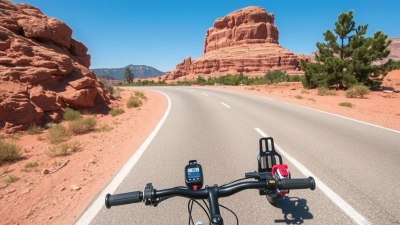How to Stay Safe While Biking in Foreign Countries
Essential tips for biking safely in foreign countries to ensure a secure and enjoyable journey.

Image created with Flux Schnell
Biking through foreign countries can be an exhilarating way to explore new landscapes, immerse oneself in local culture, and achieve a sense of freedom on the open road. However, biking in unfamiliar territories comes with its unique set of challenges and safety considerations. Here are crucial tips for staying safe while biking in foreign countries.
Research Your Destination
Before embarking on your biking adventure, it’s important to conduct thorough research on the areas you plan to visit. Investigate the local biking laws, road conditions, and common hazards faced by cyclists in that region. Understanding the local traffic rules, such as which side of the road to ride on, can help you avoid dangerous situations. Utilize resources such as travel blogs, cycling forums, and official tourism websites to gather comprehensive information about your biking route.
Know Your Gear
Familiarize yourself with your biking gear and equipment before setting off. This includes not just your bicycle but also any accessories you may be using, such as helmets, lights, and locks. Ensure your bike is in excellent working condition, and pack essential tools for minor repairs. It’s also beneficial to have a basic understanding of how to fix a flat tire or adjust your brakes in case of emergencies.
Wear Protective Gear
Protective gear is crucial when biking, especially in foreign countries where traffic conditions may differ greatly from what you are used to. Always wear a properly fitted helmet, as it significantly reduces the risk of head injuries in the event of an accident. Additionally, consider wearing reflective clothing to enhance your visibility, especially when biking at night or in poorly lit areas. Padded shorts and gloves can also improve your comfort and grip while cycling.
Stay Visible
Visibility is vital for safety while biking. Ensure you are highly visible to traffic and pedestrians alike. During daylight, wear bright colors and use reflective gear. When biking at night, equip your bicycle with front and rear lights, and consider using reflectors on your clothing or gear. Keeping your bike well-maintained and ensuring that the lights function properly can make a significant difference in staying safe.
Plan Your Route Wisely
When mapping out your biking route, prioritize safer and more bike-friendly roads. Utilize dedicated bike lanes or paths whenever possible. Avoid busy roads with heavy traffic, especially if you are not comfortable cycling in such conditions. Apps and websites like Google Maps provide options specifically for bicycle routes, which often prioritize safer paths over direct routes.
Keep Your Belongings Secure
While cycling abroad, it’s crucial to keep your belongings secure to prevent theft or loss. Use a sturdy, high-quality lock to secure your bicycle when you stop. Consider using a bike alarm for added security. Also, be mindful of how you carry your personal items. Utilize anti-theft bags or backpacks that can be securely fastened to your body. Avoid keeping valuables in easily accessible pockets or bags.
Stay Hydrated and Nourished
Proper hydration and nutrition are critical, especially when biking for extended periods. Always carry water and snacks to maintain your energy levels. Dehydration can significantly impair your physical capability and increase the risk of accidents. Pay attention to your body’s signals, and take regular breaks to rest, hydrate, and refuel. Also, familiarize yourself with local foods and dietary options available on your route to avoid any adverse reactions.
Be Aware of Your Surroundings
Maintaining awareness of your surroundings is one of the best ways to stay safe while biking. Be cautious of other road users, including vehicles, pedestrians, and other cyclists. Always anticipate potential hazards and be ready to react swiftly. Pay attention to changes in weather conditions, as rain or wind can alter road conditions or affect your visibility. Additionally, be mindful of local wildlife which may cross your path, especially in rural or mountainous areas.
Ride with a Buddy
If possible, bike with a friend or a group, as riding in numbers often provides additional safety. Having someone else with you can offer safety in numbers, making you less appealing to potential thieves. Moreover, you can assist each other in case of emergencies or unexpected situations. If you must ride solo, ensure someone knows your planned route and expected arrival times.
Understand Local Emergency Procedures
Before cycling in a foreign country, familiarize yourself with local emergency protocols. Know how to contact emergency services, as this process can vary from one country to another. Take note of the emergency contact numbers for police, ambulance, and roadside assistance in the regions you are visiting. Also, consider carrying a local SIM card to ensure you have access to communication at all times.
Trust Your Instincts
Lastly, trust your instincts. If something doesn’t feel right—be it a location, a person, or a situation—don’t hesitate to leave or reassess your plans. Safety is paramount, and it’s essential to be in tune with your surroundings. Stop and evaluate your circumstances regularly to ensure you remain safe and secure throughout your journey.
Embarking on a biking adventure in a foreign country can be an incredible experience filled with new sights and thrilling explorations. However, ensuring your safety should always remain a top priority. By preparing adequately, staying aware of your surroundings, and adopting best practices, you can enjoy a memorable and safe biking journey. Whether you’re exploring vibrant cities, beautiful countryside, or rugged landscapes, taking these safety measures will help you focus on the joy of discovering new places while protecting your well-being.











